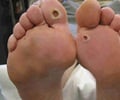- Cancer is the leading cause of death among people with diabetes
- Smoking and physical inactivity are the two most significant risk factors for mortality in type 2 diabetes patients with cancer
Improvement in the Life Expectancy of Diabetic People
“Individuals with type 2 diabetes have a longer life expectancy today than in previous decades,” says Dr Tinne Laurberg, of the Steno Diabetes Center Aarhus, Aarhus University Hospital, Aarhus, Denmark, who led the research. “This is likely due to a combination of improvements in diabetes treatment and in the prevention of cardiovascular disease. As the proportion of deaths from heart disease has declined, however, the proportion due to cancer has increased and, as a result, individuals with type 2 diabetes are now more likely to die from cancer than from cardiovascular disease. Knowing more about the factors that affect the survival of individuals with type 2 diabetes is key to stemming this rise.”What Affects the Longevity of Diabetes Patients
Breast, lung, prostate and colorectal cancer are the four most frequent types of cancer. Dr Laurberg and colleagues in Sweden and Denmark investigated the characteristics that affect the longevity of patients with T2D who develop one of these cancers.The longitudinal study comprised 655,344 T2D patients. 43% were female and registered in the Swedish National Diabetes Register between 1998 and 2019. When they were a part of the study, the average age was 63.
Following up with the participants lasted an average of seven years. At the beginning of the trial, they were all cancer-free. Over the course of the follow-up, 32,366 of them acquired one of the four malignancies.
179,627 people passed away while the study was ongoing. Nearly three times (2.89 times) as many people with cancer died from any cause as people without cancer.
The diabetes registry provided information on modifiable risk factors for diabetes, including HbA1c (average blood sugar level), cholesterol, LDL cholesterol, hypertension, BMI, cigarette smoking and physical activity.
Factors Associated with Death of Diabetic Patients with Cancer
According to analysis, cigarette smoking and a lack of physical exercise are the two risk factors most strongly associated with the demise of people with diabetes and cancer. Smokers had a 2.15 times greater chance of passing away during the trial than non-smokers did. Less than 3-5 days per week of low levels of physical exercise were linked to a 1.6-fold increase in the probability of dying.The correlations between early death and individuals with diabetes but no cancer were both cigarette smoking and inactivity.
Dr Laurberg says, “Smoking and low physical activity are habits that people probably have had throughout their lives and so may therefore have contributed both to the occurrence of diabetes and of cancer. Our results suggest that these factors not only contribute to the occurrence of these two diseases but may increase the risk of early death after diabetes and/or cancer occur.”
The researchers concluded that whether a person has cancer, smoking and physical inactivity may be the two most significant risk factors for mortality in those with T2D.
Dr Laurberg adds, “It is important that clinicians and public health practitioners focus on smoking cessation and an active lifestyle at all stages of life. The results of this study suggest this to be the case after a diabetes diagnosis; regardless of the presence of cancer.”
Source-Medindia















